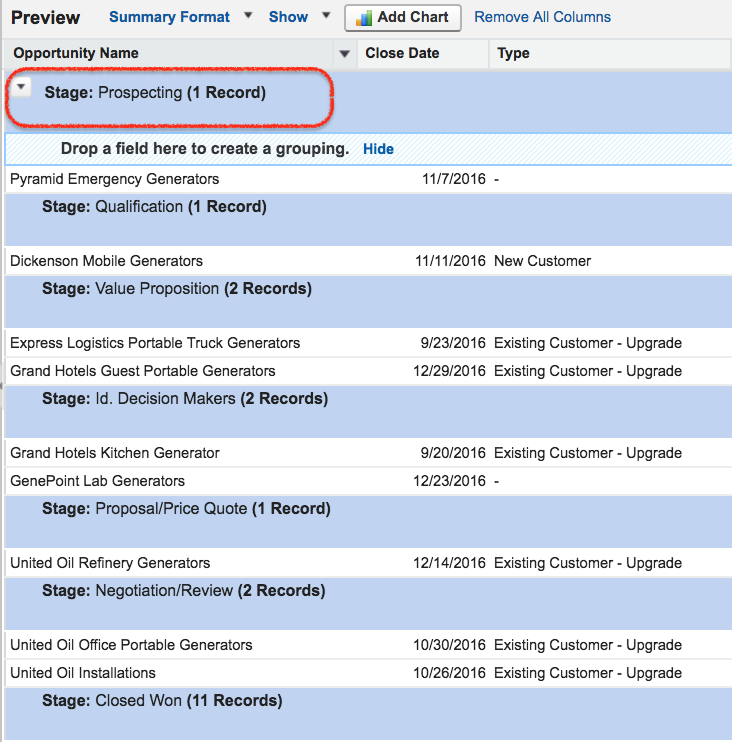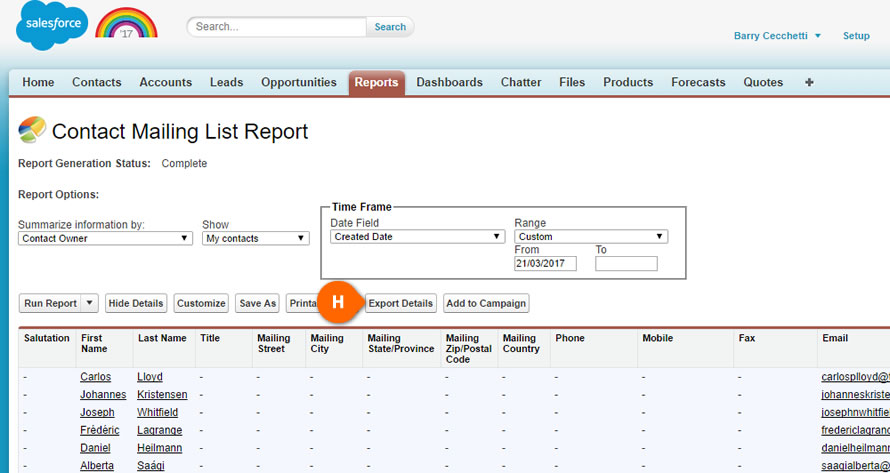
To refine the existing standard filters, Anthony clicks Show Me, and selects All Accounts and clicks Done to apply. He clicks Filters from within the filters menu to refine the data.Ĥ. Anthony selects Accounts to build a report on all the grocery stores that donate to NMH, because he knows that every grocery store has an organization account record, and clicks Continue.ģ. He uses the search box or browse using the options in the object menu. From the Choose Report Type window, he selects an object to build the report around. From the Reports page, Anthony clicks New Report.Ģ.


He tried both global search (which searches everything) and also the more targeted Reports search (which can restrict a search to a reports folder or visibility).īecause there doesn’t seem to be an existing report to answer his question, Anthony creates a new one.ġ. The grocery stores that partner with NMH have recently gone above and beyond their standard donations and have contributed additional resources to the food pantry during a period of unexpected need, and Anthony wants to send personal thank-you notes for their support.Īnthony always follows the recommended best practices, so he first searches to see if a similar report already exists. Create a New Table Report (Tabular Report) Matrix reports are best for an at-a-glance overview of totals for inventory or revenue.Īrmed with some new vocabulary, NOW it’s time to create a new report for real. These are the most complex of the three report types, but they offer the most detailed view of your data.

Grouping of rows (summary report): Summarize data, view subtotals, and create charts.These reports are the simplest to create and are best for tasks like generating mailing lists. Simple table (sometimes called a tabular report): An ordered set of fields in columns-similar to a spreadsheet.There are three different report formats, each designed for an increasing level of data complexity. Want to use a table or a graph? Need any data summarized? That’ll be determined by the format. The report format determines what the report looks like. Need information about households and in-kind gifts? Lucky for you, the opportunity report type includes opportunity and account information. This can sometimes be a difficult decision, but one way to approach it is to think of the fields you need in the report.ĭo you want to see volunteer names? Then you’ll need to select the contact object as your report type.ĭo you want to see in-kind gifts? That’s the opportunity object.

Whichever objects you choose for the report type determine what data you see in the report and what options you have to filter the data. These are the building blocks of all reports so it’s critical to understand how they shape your data before you get to the business of creating reports.Įvery report is centered around a standard or custom object (or multiple standard or custom objects). If you can’t customize an existing report to get what you need, then you should create a new report.Īnd now it’s time to do exactly that! After an introduction to two important report components. When you need a report, it’s best first to find a report that mostly meets your needs, and then customize it with filters. Most Salesforce admins also create several reports for their users during the initial Salesforce setup and configuration process. As we learned earlier, Nonprofit Success Pack (NPSP) comes with more than 60 fundraising and stakeholder reports. When Anthony needs to answer some questions using data, his instinct is to first look for existing reports before doing anything else-and that’s a wise move.
#SALESFORCE EXPORTING TABULAR REPORTS HOW TO#
But what happens when you can’t use an existing report or customize a standard report? You can create a new report-no matter what your reporting needs may be, NPSP has the tools to help you succeed! Let’s rejoin Anthony Hall, the No More Homelessness (NMH) Program Manager, as he explores how to create a new report. So we just learned that NPSP has some powerful out-of-the-box reporting functionality. Choose the right report type for a data set.After completing this unit, you’ll be able to:


 0 kommentar(er)
0 kommentar(er)
